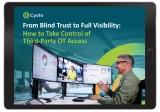Table of Contents
When production stalls, it’s natural to blame hardware failures, network issues, or perhaps a cyberattack. But there’s an even more common offender tarnishing your availability stats: delayed access.
Delayed access doesn’t crash systems with the drama of a data breach, and it doesn’t spark headlines like a ransomware attack. But that doesn’t mean it’s any less potentially crippling.
In contrast to a high-profile cybersecurity incident, instances of delayed access fly under the radar – quietly eating away at uptime, frustrating frontline teams, and leeching productivity across critical environments.
But while you understandably may not notice every time a technician wastes 10 minutes connecting to an unstable VPN, it’s impossible to ignore the fact that industrial manufacturers lose as much as $50 billion a year due to unplanned downtime.
Delayed Access: The Waiting is the Hardest Part
Consider this scenario:
A critical CNC machine is down, and only a certified OEM technician is permitted to touch it. The technician is eager to help, but first she must navigate a bureaucratic obstacle course.
Before she can even start the job, she has to:
Request remote access approval from the plant’s IT and OT leads.
Wait for the security team to provision a temporary VPN account.
Install the VPN client and complete the first round of multi-factor authentication (MFA).
Log in again through the organization’s vendor portal with another MFA challenge.
Finally, connect to the RDP session (yes, one more MFA).
By the time the technician finally reaches the console and begins to repair the malfunctioning machine, the line has been idle for over an hour — and the cost of that delay has crossed into six figures.
That’s delayed access in action.
The Hidden Costs of Delayed Access
Delayed access doesn’t break machines, but it does break your team’s ability to respond. And the ripple effects hit hard:
Missed recovery windows. Small issues snowball into full-blown outages.
Frustrated teams. Operators waste time chasing credentials instead of fixing problems.
Risky shortcuts. Shared logins, unsecured sessions, and other workarounds creep in under pressure.
Maintenance backlogs. If access is painful, routine checks get pushed off.
Real financial impact. With downtime costing around $125,000 per hour in the average industrial enterprise, even short delays compound quickly.
All of this adds up to lost productivity, higher operational costs, and probably a few extra grey hairs.
But the problem isn’t failure to recognize urgency. It’s the tools.
Traditional access models and solutions, including VPNs, VDI (virtual desktop infrastructure), and other products designed for IT settings, create friction and confusion when placed in OT environments. Because they were built for control, not speed or continuity.
In IT, extra logins are an inconvenience. In OT, they’re lost production.
As the CNC example shows, the labyrinth of approvals and layered authentications doesn’t just slow things down. It can effectively eliminate the ability to respond rapidly.
What Smarter Remote Access Looks Like
A modern, OT‑focused Secure Remote Access (SRA) approach eliminates the drag without sacrificing security. The right setup should deliver:
Fast, identity‑based access. Verify who is connecting, not just where they’re coming from. That means quick approvals and tighter controls, without the ticketing maze.
Least-privilege, zero-trust access controls. Give users the exact level of access they need (and no more) in seconds.
Full visibility and audit trails without slowing down vital work.
Agentless connectivity for all end users, including OEMs and contractors. No more extra downloads or VPN gymnastics.
When people can connect instantly but still securely, they can fix issues faster, avoid escalation, and keep the line moving.
Preventive Maintenance: The Unsung Uptime Hero
Faster, safer access doesn’t just enable better results during incidents. It also makes preventive maintenance much easier.
When connecting into OT systems is simple, safe, and secure,
OEMs can perform remote checks without weeks of scheduling or risky corner-cutting
Operators catch small issues before they spiral into downtime
Safety and compliance tasks will stop getting pushed to the backlog
Ultimately, uptime isn’t just protected during a crisis – it’s reinforced every single day.
Take Your Access From Delayed to On-Demand
Downtime isn’t just a hardware, network, or cybersecurity problem. It’s an access problem.
If your employees and vendors can’t connect quickly and securely during critical moments, your uptime will always be at risk.
But by rethinking access as an uptime enabler and not just a gatekeeping tool, your organization can:
Respond faster to potential incidents
Take full advantage of OEMs and contractor expertise without adding risk
Reduce downtime costs
Keep predictive maintenance on track
Give your frontline teams the speed and confidence they need
A smarter secure remote access strategy turns connection time into production time by shrinking delays, strengthening controls, and giving teams the speed they need to respond.
If you’re ready to close the gap between issue and action, it’s worth seeing how an OT‑first SRA strategy can support that shift.
Cyolo PRO (Privileged Remote Operations) is an SRA solution built for OT and designed specifically to help plants deliver fast, controlled access that keeps operations running.
The Manufacturers’ Guide to Secure Remote Access for OT
8 Tips for Choosing a Future-Proof Solution

Jennifer Tullman-Botzer
Author
Jennifer Tullman-Botzer has over a decade of experience in cybersecurity marketing and is as tired as you are of hackers-in-hoodies stock images. She joined Cyolo in 2021 and currently serves as Head of Content. Prior to Cyolo, Jennifer worked in a variety of marketing roles at IBM Security. She lives in Tel Aviv, Israel.

Subscribe to Our Newsletter







